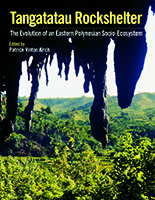Item record
Documentation
Sediment analysis methods
At the end of the 1989 field season, during the recording of the stratigraphy of the C30–G30 trench, a series of 30 sediment samples were taken from the trench’s west face. Each sample was collected exclusively from a single bed in the described section and placed directly into a leak-proof heavy plastic bag for shipment to the lab. In addition, samples were also taken from features F2, F4, and F5, all exposed in the trench wall, from the R30–S30 test trench outside of the shelter and from grid unit F10 (five samples). The samples were subsequently analyzed in the geoarchaeology laboratory of the Archaeological Research Facility, Berkeley using a sedimentological (as opposed to pedological) approach. The sediment samples from the sampled beds were analyzed for physical and chemical characteristics to aid in determining the source, mode of transport and deposition, and subsequent postdepositional alteration of the bed’s constituents (see Folk 1974; Stein 1985, 1987).
Analytical Methods
The laboratory methods used for the analysis of the MAN-44 sediment samples were identical to those reported by Kirch et al. (1993) for the To‘aga site in Samoa. Laboratory work was carried out by then Berkeley graduate student Jim Allen under the supervision of Kirch.
After air drying, Munsell colors for each sample were recorded. The pH of each sample was determined using a Mettler automatic pH meter with a 20-g subsample prepared in a 1:1 solution with distilled water. Three readings were made for each sample, with the reported value being the mean of the three readings.
Grain size distribution was determined by mechanical sieving of a subsample through nested geological sieves with mesh sizes of –2 φ (4 mm) to 4 φ (0.0625 mm), representing the range from small pebbles down to very fine sand on the Wentworth grade scale. Following sieving, weights of each fraction were determined on an Ohaus high-precision balance and the separate fractions bagged and retained for further study as necessary. The percentages and cumulative percentages of all φ size classes were then calculated.
Organic matter and carbonate content of the sediments was determined with a further subsample using the “loss-on-ignition” method of controlled heating in a Thermolyne muffle furnace. After initial weighing with an Ohaus precision balance, the sample was first heated to 550oC, at which temperate organic matter burns off completely. After cooling and weighing, the sample was then reheated to 1,000C, at which point the calcium carbonates in the sample devolved to carbon dioxide gas; the sample was again cooled and weighed a final time, after which the percent organic and percent carbonate matter were calculated.
The final analysis involved examination of the 0 φ size fraction for its constituent components. For this, a slide preparation was made of the sieved 0 φ size fraction by fixing several hundred grains to the slide surface with glue. The slide was then examined under a lowpower stereomicroscope and approximately 200 grains were individually categorized as follows: sea urchin fragments, charcoal particles, bone fragments, plant material, marine mollusk fragments (shell), land snails, rock, or crustacean fragments. After counting, percentages of each category were calculated.
Reuse
Kirch, Patrick V., 2017. Point counting of 0 phi size class, percent data. https://doi.org/10.25346/S6/3RRQ6I
